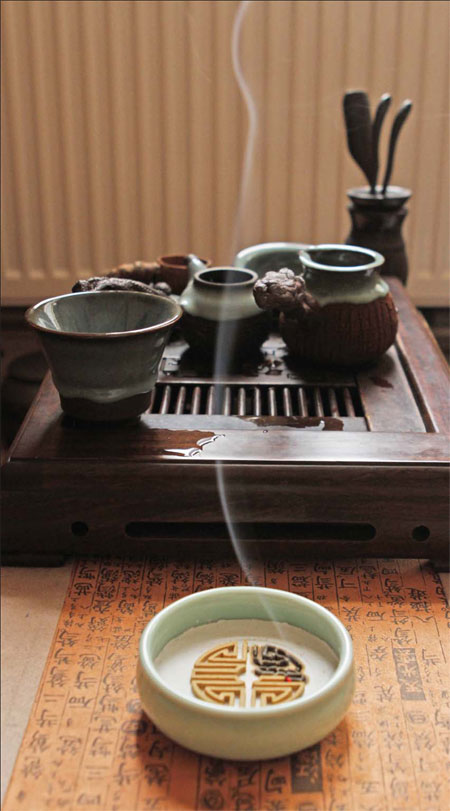Something in the air
Updated: 2013-03-22 09:07
By Yin Yin (China Daily)
|
|||||||||||
|
Chinese incense art is significant for health and well-being, as well as for enjoyment and ritual use. Provided to China Daily |
For centuries incense has been used in China to heal, relax, inspire and as an aid in meditation
While sitting listening to her zither teacher play, Kate Bennett smelt a fine aroma waft past her. It was the British student's first encounter with Chinese incense, its smoke coming from a nearby bronze censer.
"It was clean, pure and light," she recalls.
During a calligraphy class in one of Beijing's old courtyard houses, a light smoke wafts within the walls inspiring student Yang Yue.
"The smoke sometimes grows into curves, fine spray and clouds," he says. "When I write Chinese characters freestyle, the smoke helps me create a free style, but when I want to transcribe Buddhist scriptures it can help me find inner peace."
Incense and fragrances have been a part of Chinese culture for thousands of years. Fragrance first appeared before the Warring States Period (475-221BC) in the form of herbs used to cure or prevent disease.
The ancient Chinese book Collection of the Mountains and Seas records people wearing tonka beans to treat skin diseases.
In the Han Dynasty (206BC-220AD) spices were commonly used in the imperial household and by aristocrats as a perfume. According to the Han Palace Code, a book on etiquette of the time, ministers were required to make their court dress fragrant before meeting the emperor
The use of incense remains widespread across China today. Teng Jun, an incense maker says: "The Chinese burn incense throughout the country, from wayside temples to prestigious monasteries, from country homes to top hotels. Many say that burning incense became a way for people to show respect to the deities, but most people have no consciousness about the art of incense.
"Incense art pertains only to the use of natural scented woods, not artificial substitutes. I principally use Chinese herbs, for example sandalwood, Angelica dahurica and Ageratum. They can cure some ailments if people use them for a long time. So Chinese incense art is very significant for health and well-being, as well as for enjoyment and ritual use."
In the Tang Dynasty (AD 618-907), which is known for its extravagance, China's nobility began to experiment with incense and fragrance, using balls and bags filled with aromatic substances hidden among their clothes.
Records from that time refer to a princess called Tongchang passing through the streets in a carriage with the smell of her perfume floating through the city.
The golden age of Chinese incense came during the Song Dynasty (960-1279), when literature and aesthetics were blossoming across the country. Burning incense became a popular hobby in cultured circles and evolved into a kind of art form. Many scholars believed incense could spark inspiration and creativity.
Using incense gradually came to be regarded as a form of philosophy that transcended social boundaries.
From the Song Dynasty to the Ming Dynasty (1368-1644), the use of incense became intertwined with Zen and meditation.
Its use continued to develop in the Qing Dynasty (1644-1911) as it was used increasingly by common people.
Teng says the process of making incense is careful and cultured. "The first step is to pick out suitable materials to mix," he says. "It's very important to decide what materials will dominate the main aroma, what materials will help the fragrance spread out and what materials will embellish it. The second step is to grind these materials in order to preserve their essence. Sometimes the combined materials require a certain temperature and humidity to ferment."
There are various ways to burn incense. The most common are coils and sticks, which just need to be lit. Often incense is also heated on a mica plate set above a charcoal fire.
"The process of the burning ceremony can calm you down," Teng says. "The swirling smoke and fragrance can give your mind peace and space to think."
The art and use of incense has never been lost in China, and in recent decades has experienced a renaissance, with more people using it and learning how to make it.
"One of my students told me that the fragrance and smoke of a light incense could relieve work pressure," Teng says.
It is commonly used as a form of air freshener and burnt in temples to bring good fortune. Usually, mass produced incense is used.
"The art of Chinese incense is now a lot more about some social rites and is often paired with a tea party, guqin [musical instrument] performance, calligraphy and Chinese painting," Zheng says.
Few people know the ancient rituals once associated with incense or use the best substances such as genuine Santalum album, Chinese eaglewood, ambergris, says Zheng Zhenze, a professor at the Chinese Folklore Society.
yinyin@chinadaily.com.cn
(China Daily 03/22/2013 page26)
Today's Top News
List of approved GM food clarified
ID checks for express deliveries in Guangdong
Govt to expand elderly care
University asks freshmen to sign suicide disclaimer
Tibet gears up for new climbing season
Media asked to promote Sino-Indian ties
Shots fired at Washington Navy Yard
Minimum growth rate set at 7%
Hot Topics
Lunar probe , China growth forecasts, Emission rules get tougher, China seen through 'colored lens', International board,
Editor's Picks

|

|

|

|

|

|






